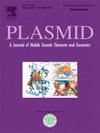Discovery and assembly of plasmids in the fish pathogen Tenacibaculum
IF 2.2
4区 生物学
Q3 GENETICS & HEREDITY
引用次数: 0
Abstract
Members of the marine bacterial genus Tenacibaculum cause disease in finfish and outbreaks result in significant animal harm and losses in aquaculture around the globe. Plasmids have not been previously identified in Tenacibaculum, but long-read DNA sequencing of genomes from disease-associated Tenacibaculum isolates collected between 2017 and 2020 in British Columbia, Canada, revealed circular putative plasmids in three Tenacibaculum species. In addition to high-quality circular assembly, the putative plasmids contained genes encoding plasmid replication, mobility, and partitioning proteins. Genes for type B conjugation machinery and type 6iii secretion system components were also identified on each of the two largest plasmid sequences. Several protocols were tested to visualize and enrich Tenacibaculum plasmid DNA. Rolling-circle replication with Phi29 DNA polymerase amplified putative plasmids smaller than 100 kb. Alkaline lysis extraction provided weak enrichment of putative plasmid DNA, but plasmids could not be confidently resolved by Eckhardt extraction and electrophoresis in agarose gels. The newly assembled plasmids matched previously sequenced Tenacibaculum contigs, suggesting that publicly available Tenacibaculum genomes contain unrecognized plasmids. The discovery of putative plasmids in Tenacibaculum is significant because plasmids often confer important functions to host cells and serve as vehicles for horizontal gene transfer within and beyond the host bacterial species.
鱼病原体腱藻质粒的发现与组装。
海洋细菌tenacacbaculum属的成员可引起鱼类疾病,其爆发对全球水产养殖造成重大动物伤害和损失。此前在Tenacibaculum中未发现质粒,但对2017年至2020年在加拿大不列颠哥伦比亚省收集的与疾病相关的Tenacibaculum分离株基因组的长读DNA测序显示,在三种Tenacibaculum物种中发现了环状质粒。除了高质量的环状组装外,假定的质粒还含有编码质粒复制、迁移和分配蛋白质的基因。在两个最大的质粒序列上也分别鉴定了B型偶联机制和6iii型分泌系统成分的基因。几种方案进行了测试,以可视化和丰富tenacacibaculum质粒DNA。用Phi29 DNA聚合酶进行滚圈复制,扩增出小于100 kb的推定质粒。碱性裂解提取提供了假定质粒DNA的弱富集,质粒不能通过Eckhardt提取和琼脂糖凝胶电泳可靠地分离。新组装的质粒与先前测序的Tenacibaculum contigs匹配,突出表明公开可用的Tenacibaculum基因组含有未被识别的质粒。质粒的发现具有重要意义,因为质粒通常赋予宿主细胞重要的功能,并作为宿主物种内外水平基因转移的载体。
本文章由计算机程序翻译,如有差异,请以英文原文为准。
求助全文
约1分钟内获得全文
求助全文
来源期刊

Plasmid
生物-遗传学
CiteScore
4.70
自引率
3.80%
发文量
21
审稿时长
53 days
期刊介绍:
Plasmid publishes original research on genetic elements in all kingdoms of life with emphasis on maintenance, transmission and evolution of extrachromosomal elements. Objects of interest include plasmids, bacteriophages, mobile genetic elements, organelle DNA, and genomic and pathogenicity islands.
 求助内容:
求助内容: 应助结果提醒方式:
应助结果提醒方式:


